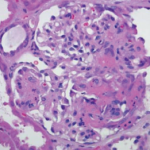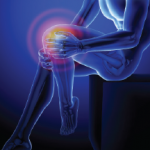Patient 2
Another case involved a previously healthy 20-year-old woman who began suffering headaches, vomiting and nausea, and was found to have lost anterior pituitary function almost completely, with a biopsy showing necrotizing granulomatous hypophysitis. She was started on prednisone but returned three months later after three weeks of fevers, severe headaches, coughing (including hemoptysis) and other problems. She was found to have large, cavitating infiltrates on chest X-ray, and cavitary lesions with thick, irregular margins on chest CT. Her PR3-ANCA measured 686.
She was diagnosed with granulomatosis with polyangiitis (GPA) with an initial presentation of granulomatous hypophysitis.
CNS involvement in GPA appears in only about 1% of cases, Dr. Chung said, and among those cases, pituitary involvement isn’t common either. But the pituitary can be affected in three ways: in situ granulomatous infection, frank vasculitis of the pituitary vessels and extension of granulomatous inflammation from neighboring structures, such as the sinuses.
In the largest case series on the topic, nine of 819 patients with GPA were found to have pituitary involvement, with eight having active GPA at other sites at the time of diagnosis. The most common symptoms included headache and excessive thirst. Diabetes insipidus and hypogonadism were both found in seven of the patients.
All nine patients were treated with corticosteroids, with eight needing additional immunosuppression. Eight eventually needed hormone therapy.
GPA involving the meninges is more common—approximately 10% of cases, Dr. Chung said.
The woman in this case was treated with rituximab rather than the typical cyclophosphamide, and she now shows no evidence of active CNS or pulmonary disease, although her pituitary function has not recovered.
“Our gut-instinct, go-to medication in these situations tends to be cyclophosphamide. We’ve been using cyclophosphamide now for over 40 years in ANCA-associated vasculitis, and we know it works,” Dr. Chung said.
In this case, however, the woman was of child-bearing age, and there was a concern cyclophosphamide could affect fertility. Another consideration: Her pituitary function hadn’t recovered even after high doses of prednisone.
“The likelihood she would have pituitary recovery even with cyclophosphamide use was really low,” Dr. Chung said. “So we elected to treat her with rituximab.”
Assessing & Treating Axial Spondyloarthritis

Dr. Gensler
Lianne Gensler, MD, director of the Axial Spondyloarthritis Clinic at UCSF, offered tips on handling suspected cases of axial spondyloarthritis (axSpA). First, when you initially assess a patient and get their history, keep in mind their pain might not actually be where they say it is. For example, a patient might think their pain is in their hip, but then point to a location other than the hip.


